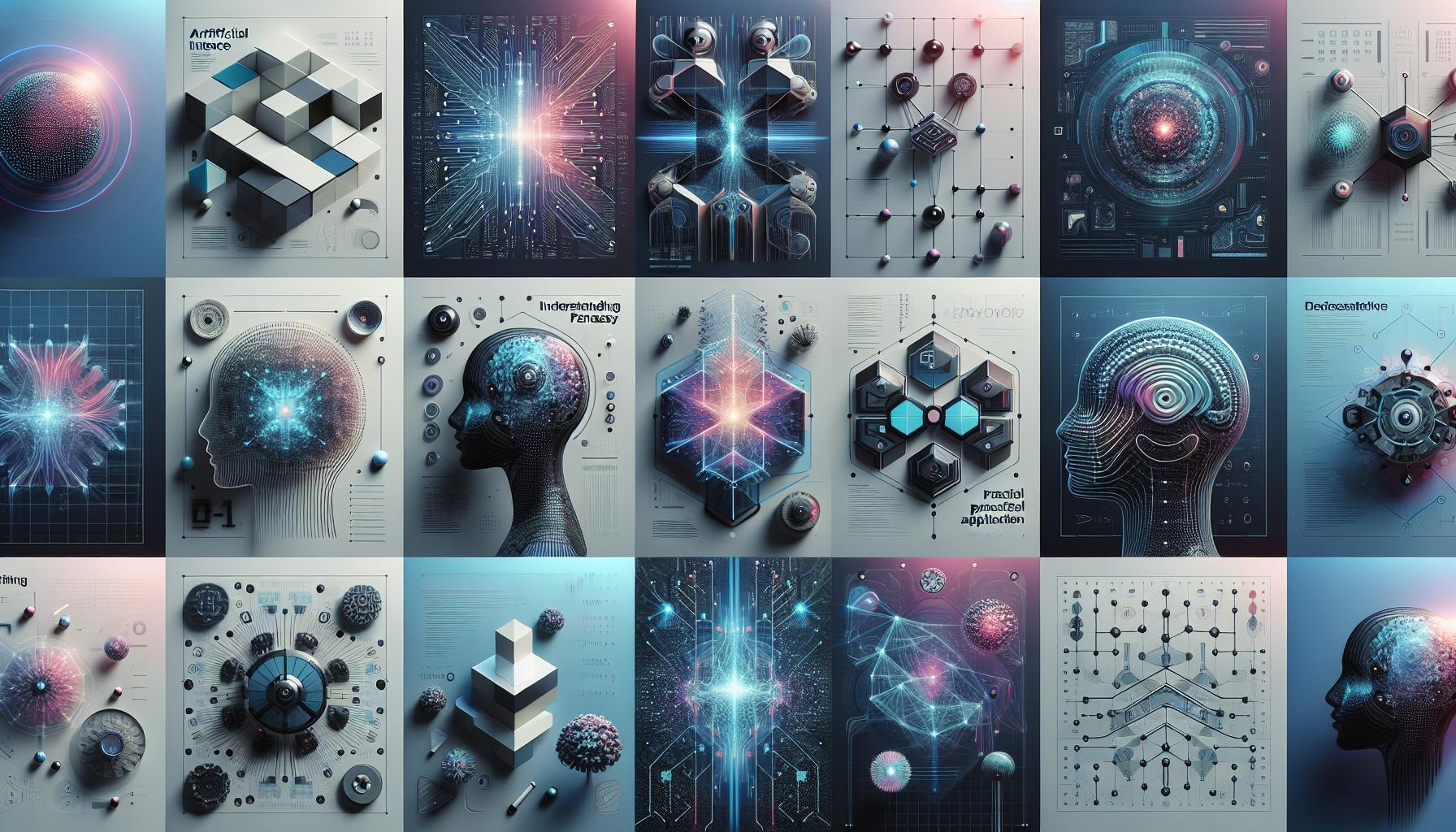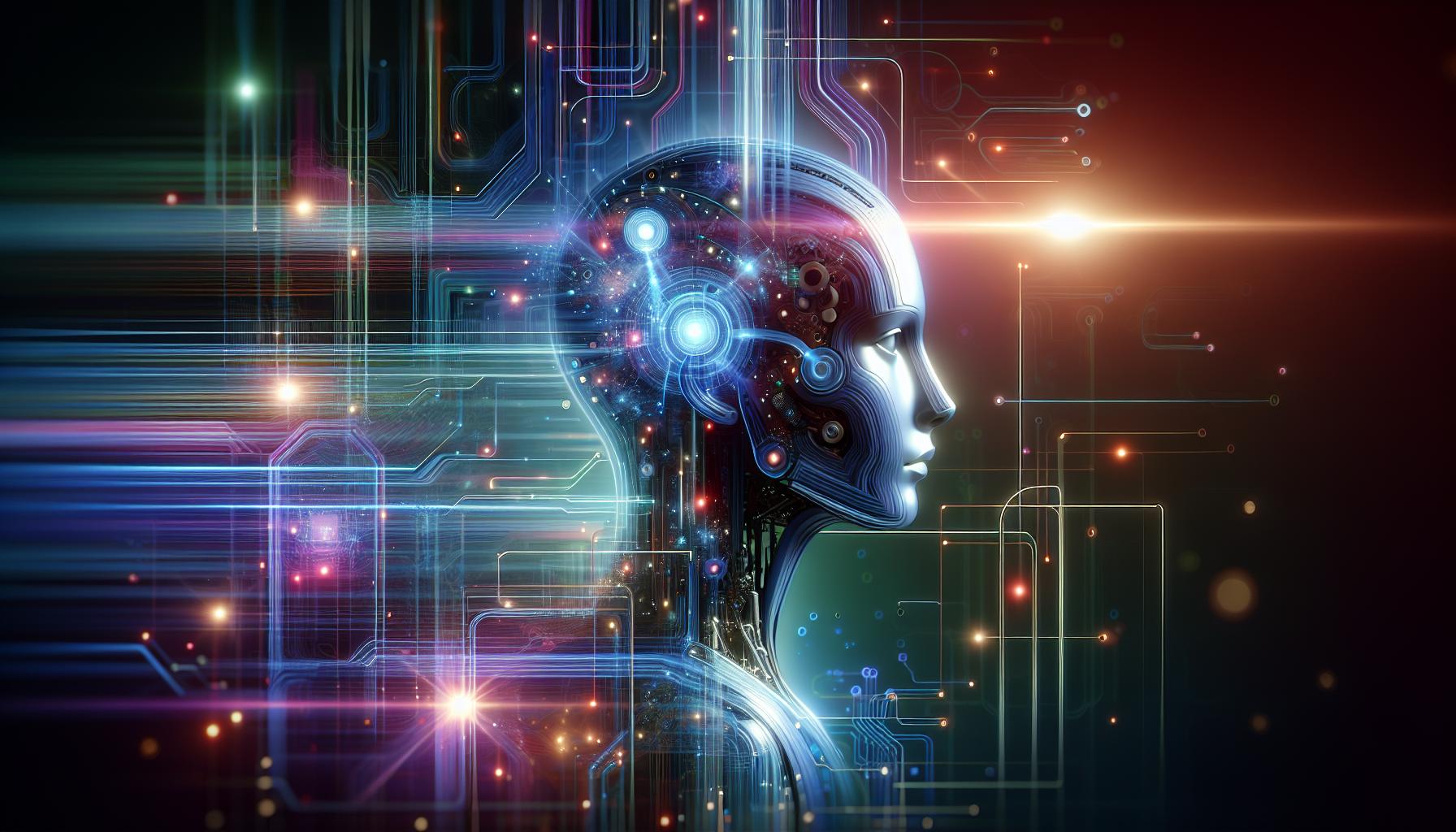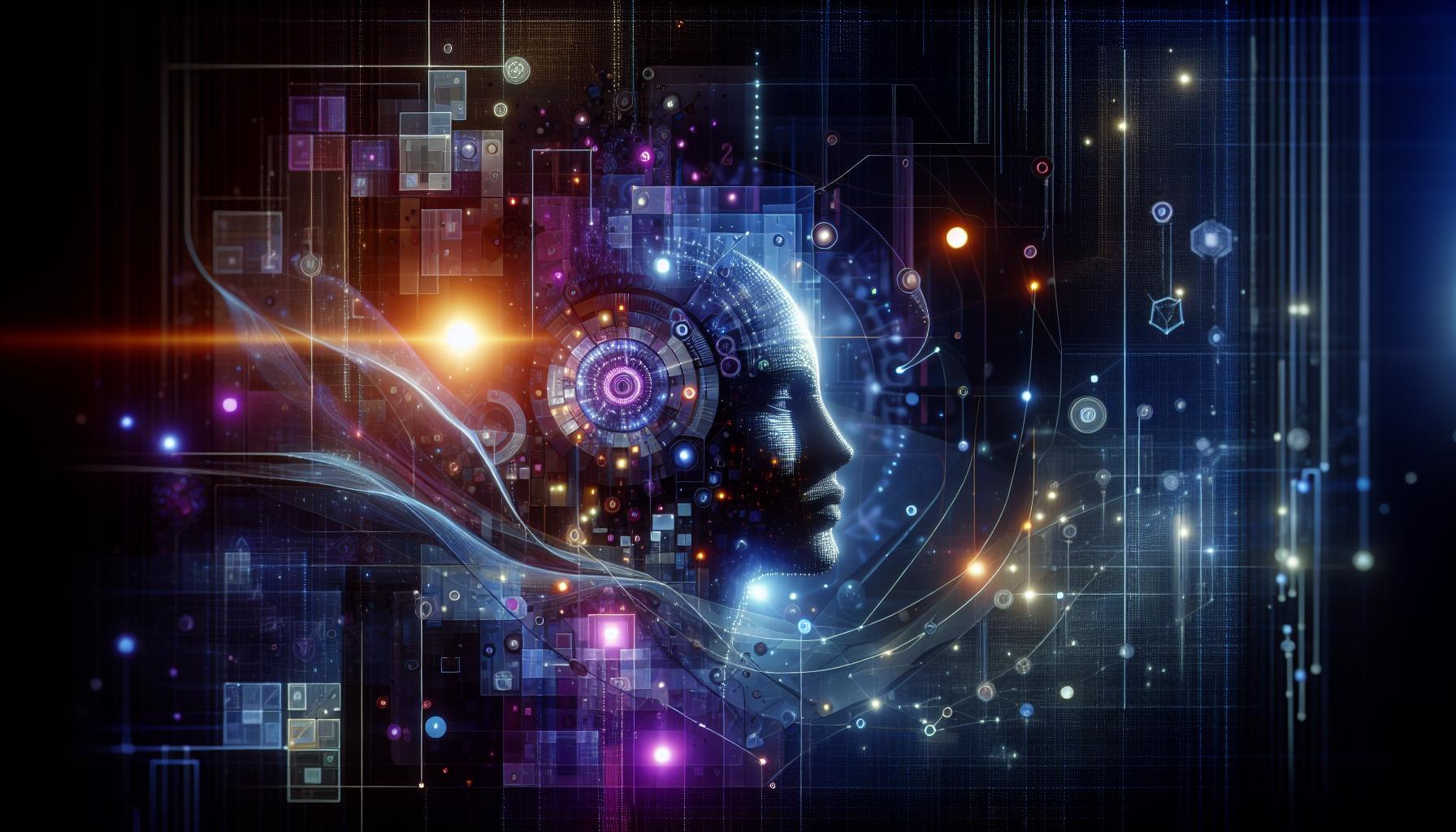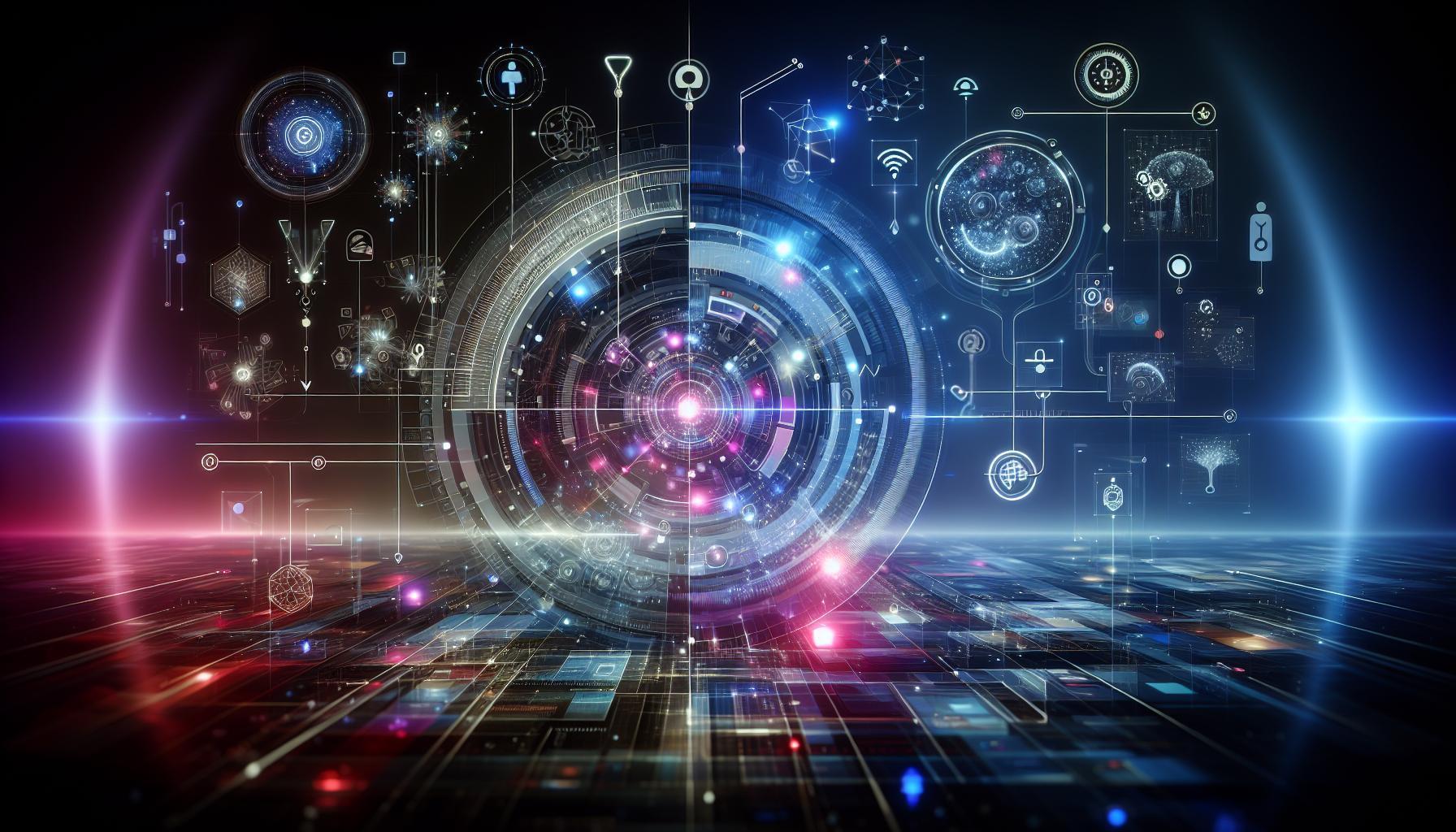In a world where creativity often struggles against the boundaries of imagination, harnessing AI to generate captivating dark fantasy visuals presents an exciting solution. This exploration into AI-driven prompts unlocks new realms of artistic expression, making it essential for creators, writers, and art enthusiasts to embrace cutting-edge technology in cultivating their dark narratives.
Understanding Dark Fantasy: Themes and Aesthetics

Dark fantasy captivates the imagination by intertwining elements of the fantastical with the sinister, creating a unique aesthetic that resonates deeply with its audience. This genre often serves as a mirror to our own world, reflecting our deepest fears and darkest desires while exploring themes of morality, identity, and the human condition. The richness of dark fantasy is particularly evident in its ability to evoke emotions and provoke thought, transporting readers and viewers into realms where the boundaries between good and evil blur.
Incorporating a host of themes, dark fantasy frequently delves into the struggles of power, betrayal, and the supernatural. Characters are often complex, grappling with inner demons and external threats that challenge their moral compasses. The portrayal of mythical creatures—be it dragons, wraiths, or dark sorcerers—adds depth to these narratives, as they often embody the fears that dwell within humanity itself. For instance, tales of tragic heroes and merciless villains illustrate the darker sides of ambition and revenge, inviting readers to ponder the consequences of their choices.
The aesthetics of dark fantasy play a crucial role in immersing the audience in these hauntingly beautiful worlds. Visual elements are rich and evocative, often highlighting contrasts—such as stark light against inky shadows—that enhance the overall atmosphere. Settings may include decrepit castles, shadowy forests, or dystopian landscapes, all designed to evoke a sense of foreboding and mystery. Such environments not only add to the storytelling but also shape the emotional landscape for the audience, making the experience more visceral.
To harness the essence of dark fantasy in art and storytelling, one might consider using Dark Fantasy AI Prompts to inspire creativity. These prompts serve as a springboard for artists and writers aiming to explore the shadowy depths of their imagination. Whether through visual art that plays with dark colors and eerie themes or narratives that delve into the macabre, these tools can help unleash creativity and bring haunting stories and imagery to life. Engaging with these prompts can lead to unique interpretations of classic tropes, allowing creators to express their own visions while staying true to the genre’s distinct allure.
The Role of AI in Creating Captivating Fantasy Art

The modern intersection of technology and creativity has given birth to a new paradigm in the realm of fantasy artistry. With the power of artificial intelligence, artists and enthusiasts can explore realms of imagination that were previously bound by the limitations of manual creation. The phenomenon of using AI to generate fantasy art, especially within the dark fantasy genre, allows for the blending of surreal themes, intricate landscapes, and ethereal beings, crafting visual experiences that captivate and inspire.
How AI Enhances Artistic Vision
One of the most profound advantages of utilizing AI in the creation of dark fantasy art is its ability to generate stunning visuals through deep learning algorithms. These systems analyze vast datasets of existing artworks, enabling them to mimic styles and synthesize original pieces that resonate with thematic elements such as mystique and horror. For artists, the integration of AI can streamline the creative process, allowing for rapid prototyping of concepts and exploration of diverse aesthetics. Among the benefits:
- Speed and Efficiency: AI can create variations of art in a fraction of the time it would take an artist to manually sketch or paint.
- Innovative Design Generation: Artists can input specific dark fantasy prompts, allowing AI to generate unique backdrops, characters, and scenes that fuel the imagination.
- Iterative Process: AI-generated art can serve as a starting point, allowing artists to refine and adapt AI suggestions into their individual style.
Bridging Creativity and Technology
The fusion of AI capabilities with human creativity opens up exciting avenues for storytelling through art. For instance, a user could input dark fantasy AI prompts—ranging from “mysterious forests shrouded in mist” to “haunted castles overlooking desolate landscapes”—into an AI art generator. The result is a visually stunning array of potential artwork that can ignite an artist’s inspiration. This technology does not replace the artist but rather empowers them to visualize concepts that push the envelope of traditional fantasy art.
Real-world examples of successful AI-driven fantasy art are becoming more prevalent. For example, consider an AI model generating cover art for novels in the dark fantasy genre. When authors collaborate with AI, they can visualize their stories and enhance the narrative impact with evocative imagery that evokes curiosity and intrigue. This collaboration also makes fantasy art more accessible, encouraging budding artists to explore their creativity without the fear of technical limitations.
A Practical Guide to Incorporating AI in Your Art
For artists excited to dive into the world of AI-generated fantasy art, incorporating these tools into your workflow can be straightforward:
- Identify Themes: Start by brainstorming specific themes or elements you want to explore within dark fantasy.
- Select the Right Tools: Use platforms that allow for inputting detailed prompts and generating images, such as DALL-E or Midjourney.
- Refine and Modify: Once you receive AI-generated outputs, tweak and refine the details to align with your artistic vision.
By embracing the possibilities of AI in art creation, artists can unleash their creativity in darker, more evocative ways that resonate with audiences and capture the essence of dark fantasy art to a new degree.
Crafting Your Dark Fantasy Narrative: Tips for Effective Prompts

The allure of dark fantasy narratives lies in their ability to weave the haunting and the beautiful into a tapestry filled with suspense, adventure, and moral complexities. Engaging with dark themes allows writers and creators to dive into the depths of human emotion and imagination. When leveraging Dark Fantasy AI Prompts, it’s essential to not only seek inspiration but to craft lines that draw readers or viewers into your shadowy worlds. Here are some effective strategies to elevate your storytelling experience.
Embrace Archetypes and Complex Characters
One of the fundamental aspects of dark fantasy is its rich character development. Using AI-driven prompts, you can explore traditional archetypes while infusing them with complexity. Here are a few character prompts to guide your creativity:
- The Fallen Hero: A once-noble warrior who has succumbed to darkness for revenge.
- The Cursed Seer: A character with the gift of foresight that brings calamity instead of salvation.
- The Reluctant Villain: An antagonist with a tragic backstory that evokes sympathy.
- The Grieving Monarch: A ruler coping with loss while facing catastrophic threats to their realm.
These character archetypes allow for deep emotional exploration and highlight the moral gray areas that define dark fantasy worlds.
Create Striking Settings
An effective dark fantasy narrative hinges on the settings that evoke dread and intrigue. AI prompts can guide you in crafting vivid, atmospheric locations. Consider using rich sensory details to bring your environments to life. For example:
- Crumbling Castles: Describe ancient stones whispering forgotten secrets under cold moonlight.
- Dark Forests: Paint a scene with twisted trees and echoing howls that send shivers down the spine.
- Ghostly Cities: Balance the allure of grandeur with the eerie silence of abandoned streets.
Using AI to generate specific scenes can help you envision these settings more clearly, ensuring that they contribute effectively to your narrative’s mood.
Weave Intricate Plots
An engaging dark fantasy story thrives on its plots laden with twists and moral dilemmas. AI prompts can assist in crafting narratives that challenge your characters and engage your readers. Consider utilizing the following plot structures:
| Plot Element | Description |
|---|---|
| Dual Realities | Characters experience events in both the waking world and a nightmarish alternate reality. |
| Family Secrets | A protagonist uncovers dark truths about their lineage that reshape their identity. |
| Forbidden Alliances | Exploring alliances with unlikely or morally ambiguous characters for survival. |
| Prophecy of Doom | Characters race against a prophecy that foretells their downfall, leading to unexpected choices. |
Incorporating these elements can deepen your narrative impact, keeping your audience on the edge of their seats as they follow your characters through their trials.
By carefully crafting your dark fantasy narrative with these prompt strategies, you are not merely telling a story; you are conjuring a world that captivates and terrifies, drawing readers into the exhilarating shadows. Utilize the power of Dark Fantasy AI Prompts to unleash your creativity and bring your imaginative visions to life.
Exploring Visual Elements: Colors, Shadows, and Composition
In the realm of dark fantasy, visual storytelling hinges profoundly on the not-so-subtle interplay of colors, shadows, and composition. While narratives may conjure vivid images in our minds, it’s the artist’s palette that breathes life into those visions, allowing viewers to immerse themselves in a world where the chiaroscuro technique reigns supreme. A rich understanding of color theory, impactful shadowing, and intentional composition not only enhances digital artwork but also ensures that each piece resonates with the allure and mystique that dark fantasy embodies.
Colors: The Emotional Palette
Color plays a pivotal role in evoking emotions and setting the mood within a piece. Dark fantasy art typically employs a palette dominated by deep, rich hues such as midnight blues, somber grays, and blood reds, creating a surreal atmosphere. Here are some tips for utilizing colors effectively in your dark fantasy creations:
- Contrast is Key: Pairing bright colors against a darker background can create striking focal points that draw the eye. For example, if you incorporate a vibrant splash of crimson, its stark opposition to a shadowy landscape can heighten the drama of the scene.
- Symbolic Meanings: Consider the emotions that specific colors evoke. Dark purples might symbolize mystery and magic, while green may evoke themes of decay or renewal.
- Gradient Techniques: Use gradients to create depth, allowing hues to blend seamlessly from one to another. This can amplify the feeling of encroaching shadows or the hazy atmospheres common in dark fantasy landscapes.
Shadows: Crafting Depth and Dimension
Shadows are not mere afterthoughts in dark fantasy art; they are essential elements that infuse the artwork with depth and intrigue. An effective use of shadows can lead the viewer’s gaze and create a profound sense of mystery. Consider these practices when deploying shadowing techniques:
- Soft vs. Hard Shadows: Use soft shadows to evoke a sense of realism in your characters and environments, while hard shadows can add a dramatic flair, enhancing the tension within darker themes.
- Layering Shadows: Implement multiple layers of shadows to create a more immersive experience. For instance, multiple overlapping shadows can suggest movement or danger lurking in the background.
- Directional Lighting: Establish a light source within your composition. This practice clarifies the dynamics of shadows and can significantly influence the mood. A dim light source casts elongated shadows that can evoke eeriness in a forest setting.
Composition: Guiding the Viewer’s Journey
A carefully considered composition acts as a blueprint for storytelling within your dark fantasy artwork. It’s vital to construct your scenes in a way that leads the viewer through the narrative you wish to tell. Here’s how to craft an engaging composition:
- Rule of Thirds: Divide your canvas into thirds and position key elements along these lines or at the intersections. This technique often yields a more dynamic and engaging composition, steering the viewer’s attention to significant areas of interest.
- Leading Lines: Incorporate natural lines—such as pathways, rivers, or even the architecture of a castle—that guide the viewer’s gaze throughout the artwork. This can instill a sense of exploration and intrigue.
- Framing Techniques: Use elements within the scene to frame your main subject, whether it’s through archways, branches, or shadowy figures lurking at the edges. This brings focus and reinforces the sense of a contained, immersive world.
By harnessing the power of color, shadows, and composition, artists can weave compelling narratives through their dark fantasy artworks. Whether you aim to evoke fear, intrigue, or wonder, mastering these visual elements will allow you to unleash the shadows and create captivating pieces that invite viewers into your imaginative realms.
From Concept to Creation: Step-by-Step Guide to Generating Art
Generating compelling artwork, especially within the rich realms of dark fantasy, is an exhilarating process that blends imagination with cutting-edge technology. As you embark on this creative journey, a clear step-by-step guide can significantly enhance your experience, allowing you to transform abstract ideas into captivating visuals using AI art generators.
Step 1: Conceptualize Your Idea
Before even touching the tools, spend some time brainstorming and visualizing your concept. Consider the elements typical of dark fantasy: eerie landscapes, mythical creatures, and an atmosphere thick with mystery. Jot down keywords and phrases that evoke the essence of your scene, such as “haunted forest,” “shadowy figure,” or “ethereal glow.” This initial brainstorming phase is crucial as it lays the groundwork for the prompts you will use in the AI art generator.
Step 2: Crafting the Right Prompts
The next step involves translating your vision into compelling prompts for the AI. Here, specificity is your ally. Instead of simply stating “create a dragon,” you might say, “a dark dragon soaring above a moonlit castle shrouded in mist.” This enriched prompt not only instructs the AI effectively but also steers the resulting artwork closer to your imaginative vision. Consider breaking your prompt into key components:
- Subject: What is the focus (e.g., a castle, a creature)?
- Environment: Describe the setting (e.g., misty mountains, ancient ruins).
- Style: Specify if you want realism, cartoonish, impressionist, etc.
Step 3: Utilize AI Art Generators
Now it’s time to leverage the power of AI tools. Websites like [OpenArt](https://openart.ai/) and [DeepImg](https://deepimg.ai/ai-image-generator/) offer intuitive interfaces where you can input your crafted prompts effortlessly. Most platforms allow you to tweak settings such as artwork style and color palettes, enabling you to customize the output further. For instance, if you want a more dramatic effect, opt for a darker color scheme or a surreal style that amplifies the haunting elements of your concept.
Step 4: Refine and Iterate
Once you have your initial generation, don’t hesitate to refine your prompts or settings. AI art creation is often an iterative process. Evaluate the artwork and consider what aspects you would like to change or enhance. If the shadows are too light or if the background lacks depth, refine your prompt accordingly. Experimentation is key—each iteration can lead you closer to your envisioned masterpiece.
|
| Aspect | Initial Prompt | Refined Prompt |
|---|---|---|
| Subject | Dragon | Dark dragon |
| Environment | Castle | Moonlit castle shrouded in mist |
| Style | Realistic | Surreal, with dramatic shadows |
|
By following these steps, you can successfully navigate the process from concept to creation, leveraging AI technology to manifest the darkest corners of your imagination. Remember, the world of dark fantasy is as boundless as your creativity. Explore, create, and let the shadows come to life through your art!
Enhancing Your Art: Tools and Techniques for Refinement
Exploring the depths of dark fantasy through AI can yield captivating results, but even the most sophisticated models require a human touch to enhance the final artwork. Refinement is an essential part of the creative process, helping you to elevate your pieces from shadows to stunning masterpieces. By employing specific tools and techniques for adjustment and enhancement, artists can truly bring forth the haunting beauty embedded in their AI-generated concepts. Here’s how you can unleash the full potential of your dark fantasy art.
Key Tools for Enhancement
To refine your AI-generated dark fantasy art, leveraging advanced image editing tools can make a significant difference. Below are some top recommendations that can help you polish your creations:
- Adobe Photoshop: A staple in the industry, Photoshop excels at detail adjustments, color correction, and adding textures.
- Procreate: Ideal for iPad users, this app offers a range of brushes and effects to bring your art to life.
- GIMP: A free alternative to Photoshop that provides powerful editing capabilities to retouch and refine your artworks.
- Affinity Photo: This software delivers similar features to Photoshop but at a fraction of the cost and offers a user-friendly interface.
Techniques to Elevate Your Art
Incorporating specific techniques can greatly enhance the allure of your dark fantasy artworks. Here are a few actionable steps to refine your pieces:
- Layering: Build depth by using multiple layers in your editing software. Experiment with opacity settings to create a sense of dimension.
- Color Grading: Adjust the hues and saturation to evoke the appropriate mood. Darker tones can heighten the feeling of foreboding that is a hallmark of dark fantasy.
Color Description Deep Reds Conveys danger or passion. Dark Purples Suggests mystery or magic. Charcoal Grays Creates a somber tone. - Texture Overlay: Add texture layers to simulate surfaces like stone, metal, or fabric, giving your artwork an added sense of realism.
- Lighting Effects: Play with light sources and shadows to create dramatic contrasts, accentuating focal points in your artwork.
Incorporating these tools and techniques not only enhances the aesthetic of your creations but also ensures they resonate with viewers. By regularly experimenting with these methods, you can continually evolve your style and mastery in dark fantasy art. The interplay of AI-driven fantasy prompts and your artistic refinement can lead to captivating expressions of the shadows.
The Ethical Considerations of AI in Fantasy Art Creation
The rise of artificial intelligence in the realm of fantasy art brings a myriad of creative possibilities, but it also raises significant ethical concerns that artists, creators, and consumers alike must navigate. As AI-driven fantasy art continues to evolve and thrive, the implications of its use prompt critical discussions surrounding ownership, originality, and cultural representation. Engaging with dark fantasy AI prompts can lead to both astonishing results and unsettling ethical dilemmas.
Ownership and Intellectual Property
One of the most pressing issues in the intersection of AI and art lies in ownership. When an artist employs AI tools to create a piece inspired by dark fantasy prompts, questions arise about who owns the resulting artwork. Is it the creator using the AI, the programmers of the AI software, or possibly even the datasets used to train the AI? The situation becomes even murkier when considering pieces that appear strikingly similar to existing copyrighted works. Artists must be vigilant and ensure they possess the rightful licenses to work with various AI tools to avoid potential infringement.
- Be Transparent: If using AI-generated elements in your work, openly disclose these practices to your audience.
- Understand Licensing: Familiarize yourself with the terms of use and licensing agreements of the AI tools you utilize.
- Document Your Process: Keep a journal of your creative process, detailing how you employed AI, to clarify the intentions behind your artwork.
Cultural Representation and Sensitivity
Another critical aspect to consider is cultural representation. Dark fantasy themes often borrow elements from various mythologies, traditions, and historical narratives. While AI can produce intricate visuals that capture these influences, it can also perpetuate stereotypes or misrepresent cultures in harmful ways. The responsibility falls on creators to approach cultures respectfully and thoughtfully, ensuring that their portrayals do not contribute to cultural appropriation or misinterpretations.
| Ethical Practices | Practical Steps |
|---|---|
| Research Cultural Themes | Study the origins and significance of the elements you wish to include in your art. |
| Consult with Experts | Engage with cultural representatives or historians to gain insights and feedback. |
| Give Credit | Always acknowledge the sources of your inspiration, especially when drawing from specific cultural narratives. |
As AI-driven tools continue to influence the art world, it is essential for creators to strike a balance between innovation and responsibility. By being aware of ownership dynamics, respecting cultural contexts, and adhering to ethical standards, artists can fully embrace the creative potential of dark fantasy AI prompts while maintaining integrity within their work.
Showcasing Your Work: Platforms to Share Your Dark Fantasy Art
In the digital age, showcasing your artistic creations has never been more critical, especially in genres like dark fantasy, where imaginative interpretations reign supreme. Artists can now leverage various platforms to reach wider audiences and connect with fellow creators. From specialized art networks to social media, each platform offers unique features that cater specifically to the needs of dark fantasy enthusiasts and artists alike.
Art Communities and Platforms
One of the most effective ways to share your dark fantasy work is through dedicated art platforms where artists gather to showcase their portfolios. Websites like Behance provide a massive network for creatives to display their work and receive feedback from peers. It allows for rich interactions through project presentations that can include a variety of media from illustrations to animations. You can also use advanced search options to find audiences interested in dark fantasy art specifically [[2]].
Similarly, for those seeking more visual inspiration, sites like DeviantArt or Tumblr can be invaluable. These platforms not only allow you to upload images but also encourage community interaction through comments, favorites, and reblogs, thereby enhancing visibility and engagement with your dark fantasy art.
Visual-Driven Social Media
Social media is a powerhouse for artists in today’s landscape. Instagram and Pinterest are particularly effective for visual storytelling and can help you reach an audience that genuinely appreciates dark fantasy themes. Utilizing specific hashtags such as #DarkFantasyArt and #FantasyIllustration can significantly enhance the discoverability of your posts. Create engaging captions that reflect the essence of your work and encourage your audience to share their interpretations or experiences related to your art.
Additionally, consider using TikTok to create engaging short videos that offer insights into your creation process or showcase time-lapse videos of your illustrations. This dynamic approach not only captivates potential followers but also creates a personal connection with supporters of your dark fantasy vision.
Traditional and Online Art Shows
Participating in virtual art exhibitions is another excellent way to display your dark fantasy art. Many platforms host online galleries where artists can submit their works and potentially be featured among other talented creators. Look for art fairs and competitions focused on fantasy themes and consider entering your pieces. Such opportunities can lead to exposure, critical feedback, and even sales, all while expanding your network within the dark fantasy community.
When showcasing your work, always consider the presentation of your art. High-quality images, detailed descriptions, and engaging narratives that resonate with the dark fantasy genre will compel viewers to interact with your creations. Tools such as professional graphic design software can help enhance your visuals and make your portfolio stand out.
With these diverse platforms and strategies, artists can effectively showcase their dark fantasy art, drawing inspiration from AI-driven prompts and breathing life into shadows through their unique creative expressions.
Engaging with the Community: Collaborating and Learning Together
Engaging with a community of fellow artists and enthusiasts expands the creative horizon beyond solitary practice, especially in the realm of dark fantasy art powered by AI. When artists collaborate and share their insights, they unlock new dimensions of creativity that can elevate their work. This collaborative spirit is crucial for experimenting with Dark Fantasy AI Prompts, as diverse perspectives can lead to unique artistic interpretations and richer storytelling through visuals.
To foster a vibrant community atmosphere, consider participating in online forums or social media groups centered around AI-driven art. Here, artists can exchange ideas, share their AI-generated creations, and provide feedback on each other’s work. Engaging in challenges such as themed prompts or collaborative projects can also spark creativity. For instance, setting a monthly challenge where participants create pieces based on specific dark fantasy themes can yield surprising outcomes and deepen artistic skills.
Practical Steps for Community Engagement
One practical way to kickstart collaboration is through structured community events. Here are some steps you might consider:
- Organize Virtual Meetups: Use platforms like Zoom or Discord to host regular meetings where artists can showcase their latest creations inspired by dark fantasy prompts.
- Create Shared Portfolios: Set up a communal gallery where members can post their artwork, allowing others to comment and engage with each piece.
- Host Workshops: Encourage experienced members to lead sessions on techniques related to AI art creation, helping to demystify the process for newcomers.
For artists experimenting with Dark Fantasy AI Prompts, collaboration may also involve co-creating stories or narratives that accompany the artwork. This adds depth to visual pieces and can create a more immersive experience for the audience. Utilize this synergy to build connections that enhance your skills and foster a supportive network that thrives on creativity and shared learning.
Moreover, as you engage with the community, keep an eye on emerging trends and techniques in AI art generation. Tracking what others are creating can inspire new ideas or concepts while allowing you to refine your prompts for generating even more captivating dark fantasy art. By sharing resources, tutorials, and inspiration, artists can collectively push the boundaries of what can be achieved through AI-driven fantasy art.
Q&A
What is Dark Fantasy AI Prompts: Unleash the Shadows with AI-Driven Fantasy Art?
Dark Fantasy AI Prompts: Unleash the Shadows with AI-Driven Fantasy Art is a creative tool that utilizes artificial intelligence to generate unique fantasy art ideas inspired by dark fantasy themes.
This prompts framework combines elements of traditional fantasy with darker, more introspective themes, letting artists and writers explore new dimensions. For example, you might generate an image of a shadowy forest inhabited by mythical creatures or a haunted castle, bringing your visions to life in ways you might not have imagined.
How can I use Dark Fantasy AI Prompts for my art?
You can use Dark Fantasy AI Prompts by inputting specific keywords or themes into an AI art generator, which will then create visuals based on your prompts.
To get started, think about the elements you want to include—like a haunted landscape or mysterious figures. Many AI art platforms allow you to continually refine your prompts, helping you tailor the artwork to your vision. Check out our guide on AI art tools for more options!
Why does dark fantasy appeal to artists?
Dark fantasy appeals to artists because it allows for deeper emotional expression and explores themes like mystery, fear, and the unknown, which resonate universally.
This genre often represents the struggles between light and dark, enabling artists to delve into complex narratives. By utilizing AI-driven prompts, creators can explore these themes visually, sparking fresh ideas while interacting with the genre in engaging ways.
Can I customize Dark Fantasy AI Prompts for specific themes?
Absolutely! You can customize Dark Fantasy AI Prompts by specifying elements like characters, settings, and moods to create unique and personalized art.
For instance, if you want a prompt that includes a haunted village in fog, you can refine your input to reflect that setting. These adjustments maximize creativity and help produce artwork that really speaks to your vision.
What types of AI art generators work best with Dark Fantasy AI Prompts?
Some popular AI art generators that work well with Dark Fantasy AI Prompts include Midjourney, DALL-E, and Artbreeder, as they allow for detailed input and creative exploration.
These platforms can handle complex ideas and produce high-quality art, making them suitable for both beginners and advanced users. Experiment with different generators to see which one resonates most with your creative style!
How do Dark Fantasy AI Prompts enhance storytelling?
Dark Fantasy AI Prompts can significantly enhance storytelling by providing vivid imagery and symbolism that complements narrative themes.
Visuals created from these prompts can help authors conceptualize scenes and characters, making stories feel more immersive. For example, an illustration of a shadowy figure in a stormy landscape can deepen the emotional impact of a pivotal scene.
Where can I find resources for Dark Fantasy AI Prompts?
Resources for Dark Fantasy AI Prompts can be found on various art community websites, blogs, and AI art tutorials, focusing on dark fantasy themes and techniques.
Exploring forums like DeviantArt or communities on Reddit can provide inspiration and valuable tips from fellow artists. Websites dedicated to AI art also offer guides and prompt lists that can spark new ideas.
Final Thoughts
In conclusion, the realm of dark fantasy AI prompts offers a unique and exhilarating avenue for unleashing creativity in art. By harnessing AI-driven tools, artists can bring to life intricate worlds filled with ominous landscapes and haunting characters that provoke thought and stir emotions. Understanding the various components of these AI systems—such as neural networks and generative adversarial networks—empowers creators to gain a deeper appreciation for the technology behind their artwork.
As you embark on this creative journey, remember that experimenting with different prompts can lead to unexpected outcomes, often sparking new ideas and artistic directions. So, whether you’re a seasoned artist or just starting out, don’t hesitate to dive deeper into the interplay between AI and dark fantasy. Let your imagination run wild, and embrace the shadows as a source of inspiration. Explore further, share your creations, and join the vibrant community of artists pushing the boundaries of fantasy art with AI. The possibilities are limitless—step into the darkness and illuminate your artistic path today!





